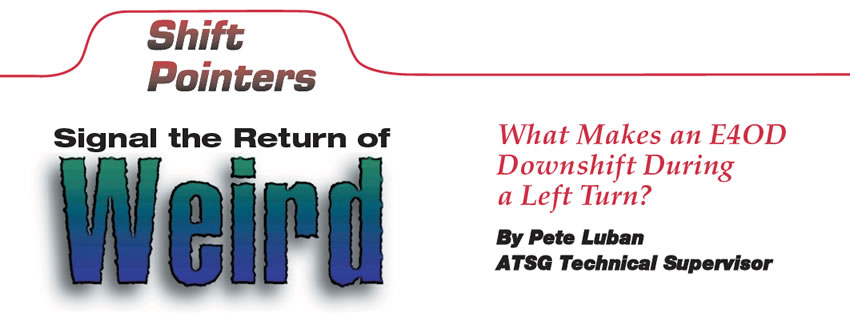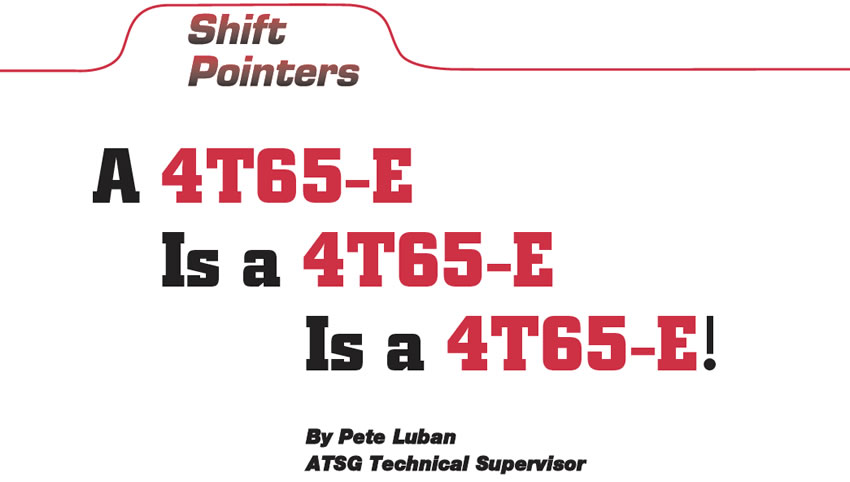Figuring Out the Fuso
We have had some confusion on the ATSG help lines in reference to 1999 and later Mitsubishi Fuso tilt-cab medium-duty trucks equipped with the Aisin Seiki.
The first problem is, how do I get codes out of these trucks? Since aftermarket scan tools do not communicate with these trucks, data is not available and code retrieval must be done via the flash-code method. That means that a certain procedure must be performed, after which a light somewhere on the dash will flash a code pattern. The illustration in Figure 1 shows the locations of the diagnosis switch and the memory-clear switch, both of which are single-pin connectors.

Signal the Return of Weird
Believe it or not, the cause of all of this was a faulty signal switch, or what Ford calls a multi-function switch. Replacing the switch solved all the complaints.

What’s in Your Wallet?
For years now, almost everyone in the automotive-aftermarket repair business has been complaining that we did not have access to the same technical information that the car dealerships have. Well, now you do! But did you think it would be free?

Zap! It’s a MAF Sensor
When a MAF sensor malfunctions, it can do so in a very subtle way. It can create an erratic or incorrect signal on initial take-off, which can cause an elongated shift. It can deliver an incorrect signal at higher engine speed, which can create shudder that could be mistaken for torque-converter-clutch (TCC) problems. It can cause coast-downshift clunks, especially as the vehicle is coming to a stop. It can even cause a slide-bump shift. It is a major input for electronic pressure control that will result in elevated line pressure.

To Flash or Not to Flash
At this point, everyone is familiar with the fact that most 1996 and later GM vehicles are equipped with computers that must be programmed (flashed) in order for the vehicle to operate properly.
What some technicians may not be familiar with is the fact that earlier GM vehicles were equipped with PCMs that are also flashable. As a matter of fact, you could have a GM vehicle as early as the 1993 model year that is equipped with a flashable PCM. This is mostly because GM was the pioneer in developing the EEPROM and the programmable process.

A 4T65-E Is a 4T65-E Is a 4T65-E!
I don’t think I have anything weird for you this month, just some differences in 4T65-E applications requiring special overhaul-kit items that you need to be aware of when it’s on your bench.

Rescue Ranger
Many times after an initial scan of the computer system, you find an electrically related solenoid code. If you’re lucky, a new solenoid fixes it, or maybe there’s a problem with the internal wiring – not so bad to fix these problems.
But then there are the times that these items do not take care of the problem. That usually means these days that an external wiring problem is causing that solenoid code.

Stuck On, Stuck Off or Just Plain Stuck
With the introduction of OBD-II, a ton of additional codes became available (remember, we were always asking for more information). In some instances, these new codes were a great help because they did not just indicate a short or an open circuit but also pointed to parameters that were out of range, which included both mechanical and electrical problems.

Another Fantastic Ford Fable
A 1997 Ford E 250 van equipped with a 4.2-liter engine and a 4R70W transmission comes into the shop with a complaint of falling out of fourth gear into third at highway speeds. In local traffic, however, the transmission acts like a C6 with a stuck governor; it remains in second gear as you come to a stop and “dunks” down into first gear.

Have You Seen My Drainback Ball?
When you unscrew the cooler-line fitting you notice that oil comes pouring freely. You now remove the cooler-line fitting, and lo and behold, there’s no #$^&*! checkball in the fitting.

It’s a Game of Tag, and You’re It!
In many instances, during the repair process it is necessary for us to disconnect the battery or the computer. Sometimes this is all it takes to create a problem in the vehicle that was not there before.
Let’s take a look at some of these “disconnect”-related problems and how to correct them should this happen to you.

A Transfer-Case Identity Crisis
So in your ever-expanding list of causes for stacked upshifts in computer-controlled transmissions, even if it is a two-wheel-drive vehicle, investigate the possibility of a four-wheel-drive-low command being the culprit otherwise known as a transfer-case identity crisis.

